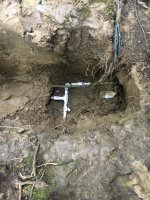All anyone here in n idaho use is the thick black poly rolls. Never heard of any failures. Our water is installed 5 feet down. Its not the Home Depot crap, I believe it’s rated 200 psi. A roll can kick your butt installing, as it can be 500 feet long and nearly impossible to unroll. Ive had it re-roll itself while I was in the trench...thought this is it.
Yep, that's the good stuff. It's important to note that HEAVY WALL Commercial well duty black poly has no comparison at all to the Home Depot black poly. Just like schedule 40 PVC from the box store doesn't compare to the commercial 20 foot belled lenghts of 80 PSI & higher UV resistant grey PVC.
I've seen some good work done with 20 foot bell end sections of sched. 80 large diameter PVC. Use sweep bends, & proper glue. Avoid short radius bends. Any pipe benefits from being sleeved.
As others say, I've seen CPVC becoming brittle too. Some of my own installations, too. Not a good product. I used it and now wish I hadn't.
For hot water inside (and gas outside) I've now gone back to copper and am using soldered and flared connections. Damn the expense; it's a good product.
For a long well line or water line you won't have any problem with that heavy high PSI thick wall black poly stuff lasting a long time. Of course you will bed it in sand. That heavy poly is fairly expensive, but is what most well installers use. However, unrolling a 500 foot roll of 1.5" 200 psi black poly so that it doesn't have an kinks & relaxes in the sun so that it can be installed as a single straight run is a real hassle, but worth the effort.
For unrolling heavy poly rolls, it helps to tie one end to a tree and have a few friends and a small tractor to help you unroll it. Give it a day in the hot sun and it will relax.
So for long runs that heavy wall my favorite today is
1 1/4 or 1 1/2inch diam heavy wall black poly. I have used a heat gun and long barbed fittings, but don't really like that because once assembled there is no constant compression. For Poly pipe I am considering changing over to compression fittings. Only thing stopping me is lack of experience with those fittings.
For constant compression of the tubing onto the fitting it is hard to beat PEX connectors with their O ring fittings compressed by the copper ring with the special PEX squeezer. That in itself is a good reason to keep PEX as an option. That and the fact that it unrolls nicely without a fight.
Have fun out there,
rScotty
